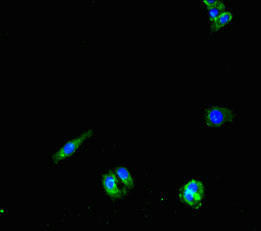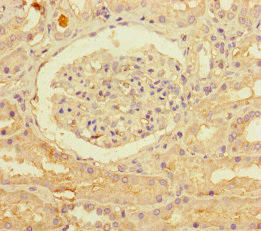Description
| Antibody Name: | PNPLA1 Antibody (PACO39106) |
| Antibody SKU: | PACO39106 |
| Size: | 50ug |
| Host Species: | Rabbit |
| Tested Applications: | ELISA, WB, IHC, IF |
| Recommended Dilutions: | ELISA:1:2000-1:10000, WB:1:1000-1:5000, IHC:1:20-1:200, IF:1:50-1:200 |
| Species Reactivity: | Human, Mouse |
| Immunogen: | Recombinant Human Patatin-like phospholipase domain-containing protein 1 protein (101-300AA) |
| Form: | Liquid |
| Storage Buffer: | Preservative: 0.03% Proclin 300 Constituents: 50% Glycerol, 0.01M PBS, PH 7.4 |
| Purification Method: | >95%, Protein G purified |
| Clonality: | Polyclonal |
| Isotype: | IgG |
| Conjugate: | Non-conjugated |
 | Western Blot. All lanes: PNPLA1 antibody at 12µg/ml. Lane 1: Mouse spleen tissue. Lane 2: Mouse skeletal muscle tissue. Secondary. Goat polyclonal to rabbit IgG at 1/10000 dilution. Predicted band size: 58, 48, 49 kDa. Observed band size: 58 kDa. |
 | Immunofluorescent analysis of HepG2 cells using PACO39106 at dilution of 1:100 and Alexa Fluor 488-congugated AffiniPure Goat Anti-Rabbit IgG(H+L). |
 | Immunohistochemistry of paraffin-embedded human kidney tissue using PACO39106 at dilution of 1:100. |
| Background: | Lipid hydrolase. Important in the formation of the epidermal lipid barrier. Plays a role in glycerophospholipid metabolism. |
| Synonyms: | Patatin-like phospholipase domain-containing protein 1 (EC 3.1.1.-), PNPLA1 |
| UniProt Protein Function: | PNPLA1: Lipid hydrolase. 3 isoforms of the human protein are produced by alternative splicing.Protein type: EC 3.1.1.-; HydrolaseChromosomal Location of Human Ortholog: 6p21.31Cellular Component: cytoplasmDisease: Ichthyosis, Congenital, Autosomal Recessive 10 |
| UniProt Protein Details: | |
| NCBI Summary: | The protein encoded by this gene belongs to the patatin-like phospholipase (PNPLA) family, which is characterized by the presence of a highly conserved patatin domain. PNPLA family members have diverse lipolytic and acyltransferase activities, and are key elements in lipid metabolism. While other members of this family have been well characterized, the function of this gene remained an enigma. However, recent studies show that this gene is expressed in the skin epidermal keratinocytes, and has a role in glycerophospholipid metabolism in the cutaneous barrier. Consistent with these observations, mutations in this gene are associated with ichthyosis in human (autosomal recessive congenital ichthyoses, ARCI) and dog. Alternatively spliced transcript variants encoding different isoforms have been found for this gene. [provided by RefSeq, Jun 2012] |
| UniProt Code: | Q8N8W4 |
| NCBI GenInfo Identifier: | 296452995 |
| NCBI Gene ID: | 285848 |
| NCBI Accession: | Q8N8W4.3 |
| UniProt Secondary Accession: | Q8N8W4,Q2A6N1, Q3SY95, Q3SY96, Q5R3L2, A3RMU3, J3JS20 |
| UniProt Related Accession: | Q8N8W4 |
| Molecular Weight: | 48,884 Da |
| NCBI Full Name: | Patatin-like phospholipase domain-containing protein 1 |
| NCBI Synonym Full Names: | patatin like phospholipase domain containing 1 |
| NCBI Official Symbol: | PNPLA1 |
| NCBI Official Synonym Symbols: | ARCI10; dJ50J22.1 |
| NCBI Protein Information: | patatin-like phospholipase domain-containing protein 1 |
| UniProt Protein Name: | Patatin-like phospholipase domain-containing protein 1 |
| UniProt Synonym Protein Names: | |
| Protein Family: | Patatin-like phospholipase domain-containing protein |
| UniProt Gene Name: | PNPLA1 |
| UniProt Entry Name: | PLPL1_HUMAN |






